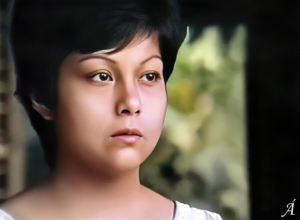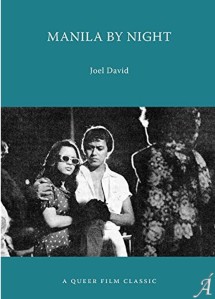Original Digital Edition (2016)
Cover design by Paolo Miguel G. Tiausas
“Bomba” © 2019 by Mina Saha
[Click on pic to enlarge]
The books I’d written as sole author were meant to be read chronologically (according to date of original publication). However, as several undergraduate students and laypersons made clear to me, that kind of effort would require an investment in which they did not (yet?) have the time or effort to commit. Hence I thought of providing Book Texts: A Pinoy Film Course, essentially a select list of recommended articles – not so much a “best of” and more of an appetizer course, pardon the semi-academic pun. This should not be construed as an introduction to Philippine cinema (although I do have a forthcoming book, SINÉ, that attempts to fulfill that function). Neither should it be considered an introduction to Philippine film criticism, or even that evasive creature that we may call “Joel David’s film criticism.” I provided a descriptor in the subtitle, and that ought to sum it up, with emphasis on the first word (cum letter) in “a Pinoy film course.”
11011Each entry is followed by the originating book title, abbreviated as follows: “NP” for The National Pastime (1990), “FV” for Fields of Vision (1995), “WC” for Wages of Cinema (1998), “MT1” for Part I of Millennial Traversals (2015), “MT2” for Part II of Millennial Traversals (2016) [click here for the unified blog entry containing both parts], “MbN” for Manila by Night: A Queer Film Classic (2017), and “AP” for Amauteurish Publishing (current); journal credits include “AJWS” for the Asian Journal of Women’s Studies and “HD” for Humanities Diliman. After the source is the year of publication – not of the collection, but of the article. A short annotation, which may or may not overtly indicate the urgency of reading the article, ends each entry.
11011To access sections without having to scroll downward, please click on any of the following:
• Autobio;
• Local Reviews (Pre-1990s);
• Local Reviews (1990s);
• Local Reviews (Digital Era);
• Foreign Reviews;
• Commentaries: Pinas;
• Commentaries: Elsewheres;
• Features;
• Interviews; and
• Metacriticism.
National Library of the Philippines CIP Data
David, Joel.
11011Book texts : a Pinoy film course / Joel David. — Original Digital Edition. — Quezon City : Amauteurish Publishing, [2016], © 2016.
11011N/A pages ; N/A cm
11011ISBN 978-621-96191-5-8
110111. Motion pictures — Reviews. 2. Motion pictures — Philippines. III. Philippine essays (English). I. Title.
791.43095991101111011PN1993.71101111011P020200162
11011“Manay Revisits Manila by Night” and “Seeds in the Garden of Letters” © 2017 by Amauteurish Publishing; “Manoy Takes His Leave” © 2019 by Amauteurish Publishing.
US Copyright Office Certificate of Registration:
TXu 2-255-103
Essays that look intensively at specific films or at film-intensive issues.
- A Second Golden Age (NP 1989). The unexpectedly influential opener of my series of books.
- Auteur Criticism: A Non‑Recuperative Reappraisal (WC 1998). A densely involved consideration of the most valuable (or destructive) Western-sourced concept in local film practice; recommended for those who intend to try out production.
- Womanliness as (Masculine) Masquerade in Psychoanalytic Film‑Texts (WC 1998). A comparative evaluation of Brian De Palma’s Dressed to Kill (1980) and Raising Cain (1992) that might be useful for those who intend to look closely into issues of genders and sexualities.
- The Multiple‑Character Film Format (WC 1998). An inspection of the complex narrative pattern utilized by Robert Altman in Nashville (1975), a film that set the template not just for similar local texts but also for studio talent-presentation strategies.
- The Golden Ages of Philippine Cinema: A Critical Reassessment (MT1 2010). An effort – the first, as far as I can surmise – to critique attempts to valorize filmic Golden Ages, including the one I had written (“A Second Golden Age” – see above).
Personal write-ups that could help people understand the writer’s psychology, to dispel any lingering illusion of objectivity.
- World’s Shortest Prequel (NP 1990). Or why my writing turned out the way it did, if childhood experience were ever capable of explaining anything.
- The Last of Lino (FV 1995). What the death of a major local practitioner signified to someone (like me) who had always regarded his output with some reservation and ambivalence.
- Ordinary People: Movie Worker (MT2 1987). A second stint at media freelancing, with the same meager income and a status adjustment from writer to laborer.
- A Cultural Policy Experience in Philippine Cinema (WC 1998). In the slipstream of a distinctive degree of cultural patronage, that of a film “support” agency mandated by the Marcos dictatorship.
- Small Worm, Big Apple (MT2 2005). Graduate studies (and survival) in New York City, during the eve of 9/11.
Pinoy Film Reviews I – Celluloid (Pre-1990s) Era
The core of any critical practitioner derives from the active consumption of cultural output within an extensive time frame – never an easy or affordable option. This was the period when local film flourished, then floundered, because of the instability wrought by the defeat of the Marcos dictatorship.
- Exceptions (NP 1981). A comparative review of Eddie Romero’s Kamakalawa and Mike de Leon’s Kisapmata (both 1981), that still relied on the style-vs.-substance approach.
- Down but Not Out (NP 1988). Another comparative review, this time of Francis “Jun” Posadas’s Nektar and Jose “Pepe” Marcos’s Tubusin Mo ng Dugo (both 1988), that looks at genre products with still a nod to issues of formal quality.
- Chauvinist’s Nightmare (NP 1987). Mike Relon Makiling’s Kumander Gringa (1987) and why its under-the-radar commercialism allowed it to get away with potshots aimed at a few sacred cows of the time.
- O’Hara Strikes Again (NP 1987). Mario O’Hara’s Tatlong Ina, Isang Anak (1987) as a demonstration of its director’s capacity to draw pleasure from formulaic material.
- Mellow Drama (NP 1987). An attempt to draw from literary history in reviewing Mel Chionglo’s Paano Kung Wala Ka Na (1987).
- Campout (NP 1988). Camp (actually campiness) as a determinant of preference in evaluating Lino Brocka’s Natutulog Pa ang Diyos, Emmanuel H. Borlaza’s Paano Tatakasan ang Bukas?, and Artemio Marquez’s Sa Puso Ko Hahalik ang Mundo (all released in 1988).
- After the Revolution (NP 1989). Lino Brocka’s Orapronobis (1989) engendered controversial responses among, predictably, conservative sectors, but even members of the intelligentsia had their misgivings; this review seeks to bridge the differences between the film and its better-intentioned interlocutors.
Pinoy Film Reviews II – Late Celluloid Era (The 1990s)
The film industry recovered after the people-power uprising, enough to recall the Marcos-era glory years and still unaware of the forthcoming storms to be induced by globalization trends, specifically the late-’90s Asian economic crisis and the digital turn in film production.
- Persistence of Vision (FV 1990). The culmination of my attempt to describe and uphold an operatic sensibility in cinema, via Chito Roño’s Bakit Kay Tagal ng Sandali? (1990).
- Indigenous Ingenuity (FV 1990). My effort at foregrounding my personal participation in Gil Portes’s Andrea, Paano Ba ang Maging Isang Ina? (1990) resulted in censorship by an editor who should have known better, and in expulsion from the publication (without the courtesy of a letter informing me of the decision).
- Head Held High (FV 1990). A review that welcomed a successful turn in Lino Brocka’s Gumapang Ka sa Lusak (1990), from his usual separation of box-office projects from political statements, to a film that demonstrated that contradictory elements need not be jettisoned from one’s intended undertaking.
- Family Affairs (FV 1990). The emergence of a politically sponsored star and her genuinely talented sidekick is interrogated in this review of Tony Cruz’s Pido Dida (Sabay Tayo) (1990).
- Men and Myths (FV 1990). A state-of-the-genre look at the action film (with dramatic and comedic elements adding extra spice) as embodied in Pepe Marcos’s Bala at Rosaryo (1990).
- I.O.U. (FV 1990). One of the occasional progressive trends that emerged in Pinoy action cinema (see “Head Held High” earlier), evaluated alongside the movie’s director-star persona, in Jesus Jose’s (a.k.a. Lito Lapid’s) Kahit Singko Hindi Ko Babayaran ang Buhay Mo (1990).
- Movable Fists (FV 1990). Further possible twists in the treatment of action material, in Junn P. Cabreira’s Walang Awa Kung Pumatay (1990), Francis (Jun) Posadas’s Iisa-Isahin Ko Kayo (1990), and Mauro Gia Samonte’s Apoy sa Lupang Hinirang (1990).
- Sedulously Cebuano (FV 1990). The last pre-digital Cebuano-language movie, Junn P. Cabreira’s Eh … Kasi … Bisaya! (1990), deserved a commemoration all its own.
- Black & Blue & Red (MT1 1992). In the tradition of short-format filmmakers who graduate to full-length projects, Raymond Red’s Bayani (1992) acquired the additional cache of representing a movement with messianic-artist claims.
Pinoy Film Reviews III – Digital Era
By the end of the first decade of the new millennium, local production had gone totally digital – unknowingly foreshadowing what more developed countries would eventually be doing.
- Heaven in Mind (MT1 2004). The new Pinay and her journey, tracked and celebrated in Joel Lamangan’s Sabel (2004).
- Survivor’s Guilt (MT1 2009). Why the personal is social, and how a filmic discourse on trauma such as Ellen Ongkeko-Marfil’s Boses (2009) can provide insight and entertainment without compromising one for the other.
- Sighs and Whispers (MT1 2009). The fullness of the aesthetic potential of the debut film, as emblematized by Armando Lao’s Biyaheng Lupa (2009).
- On the Edge (MT1 2013). Pinoy action cinema redux, featuring Erik Matti’s On the Job (2013).
- A Desire Named Oscar (MT1 2013). Among other distinctions, 2013 was the year that three countries submitted films featuring Filipino characters for Oscar consideration: Singapore with Anthony Chen’s Ilo Ilo, UK with Sean Ellis’s Metro Manila, and the Philippines with Hannah Espia’s Transit.
- Antonio Luna’s Fall and Rise (MT1 2015). The historical epic, and a misunderstood (anti)hero, are recuperated in Jerrold Tarog’s Heneral Luna (2015).
- Ice with a Face (MT1 2016). Jaclyn Jose’s Cannes-winning performance provides (among many other things) a starting point in assessing Brillante Ma. Mendoza’s new level of achievement in Ma’ Rosa (2016).
I maintain that an appreciation of foreign cinema should mainly assist in understanding local products, not the other way around; my grad-school exposure to a wide array of world cinema and film styles further affirmed this conviction.
- Form and Function (MT1 1987). Mike Newell’s Silent Voice (a.k.a. Amazing Grace and Chuck) and Stanley Kubrick’s Full Metal Jacket (both 1987) provide insights on the necessary specificities of war themes in contemporary cinema.
- …And the First Shall Be the Last (MT1 1990). A typically Catholic neurosis in pop culture, where an allegedly heretical text turns out to be ultimately pro-religion (though not always pro-Church), obtains in Martin Scorsese’s The Last Temptation of Christ (1988).
- Wet Noodles (MT1 2009). Orientalism by a fellow Oriental? Something to ponder in Trần Anh Hùng’s I Come with the Rain (2009).
- Two Guys, While Watching Avatar (MT1 2009). Plato as stand-up comedian, an approach that once more horrified square print editors, in my review of James Cameron’s all-time money-maker Avatar (2009).
- Hit in the (Multi)Plexus (MT1 2011). A Korean blockbuster, Lee Han’s Wan-deuk-i [Punch] (2011), based on a novel with a Vietnamese migrant-wife character, whose nationality in the movie was changed to Pinay.
Film is a language, as are all other forms of cultural expression. Appreciating one specific form while rejecting all others is a sign that the critic urgently needs to move forward.
- Home Sweet Home (NP 1987). A theater presentation, Elsa Martinez Coscolluela’s In My Father’s House (1987), which was originally submitted as a film proposal.
- Time and Again (AJWS 2009). Feminism as a means of engaging with salient philosophical debates on time and imagination, via Bliss Cua Lim’s essential volume Translating Time (2009).
- Disorder & Constant Sorrow (MT2 2012). The martial-law era recounted as family saga, from the experiences of the Quimpo clan, in Subversive Lives (2012).
- The Novel Pinoy Novel (MT2 2011). Language, memory, imagination, identity – all deliriously blended into an unforgettable experience, in Ricky Lee’s Si Amapola sa 65 na Kabanata (2011).
- Seeds in the Garden of Letters (HD 2017). The once and future prospects for Philippine film studies, compiled in Patrick F. Campos’s monumental volume The End of National Cinema (2016).
Film is culture, and therefore culture impinges on film, directly or otherwise. I originally envisioned these types of mini-editorials, breathers from the frankly debilitating rigors of film reviewing, as potential frameworks for future studies, and I’ve in fact managed to expand some of them in later material.
- People-Power Cinema (NP 1987). A year after the February 1986 uprising that restored democratic processes, the film industry had yet to fully recover – the films that commemorated the event were paradoxically unpopular.
- Studious Studios (NP 1988). A short (numerological) reconsideration of the political economy of the Philippine studio system.
- Shooting Crap (FV 1990). The controversial toilet-humor trend and its alleged purveyor, Joey de Leon; or why the carnivalesque can’t always be dismissed out of hand.
- Fleshmongering (FV 1990). Just shallow proof that some amateurish film “authority” wasn’t first at historicizing these trends, and even then misnaming them left and right despite the proliferation of available texts and witnesses.
- Firmament Occupation (FV 1990). A redefinition of the much-maligned star system, to take into account the implication of the word “system.”
- Blues Hit Parade (FV 1990). A pathologization of producers’ obsession with blockbusters.
No film issues get raised in these “non-Pinas” articles, which I guess buttresses the point I’m making; but it also helps any kind of reader to know that the writer proceeds from a specialization in cinema.
- A New Role for Korea (MT2 2009). Or how the Philippines could have turned out, given a different set of historical circumstances.
- Crescent Tense (MT2 2009). The massacre in Maguindanao as an index of long-simmering Muslim-Christian tensions.
- Asian Casanovas (MT2 2010). “Cablinasian” Tiger Woods, Korean Lee Byung-hun, and Pinoy Manny Pacquiao as randy celebs, positioned at the intersection of race and gender.
- The Sins of the Fathers (MT2 2010). The ending of innocence, courtesy of duly certified shepherds of the flock.
Pinoy film people, all in the mainstream. No apologies on my end.
- Love Was the Drug (MT2 2009). The introduction to the anthology left behind by the genuinely beautiful Johven Velasco.
- The Dolphy Conundrum (MT2 2012). The difficulty of ascertaining whether the country’s top comedian deserved to be honored as a National Artist.
- Manoy Takes His Leave (AP 2019). The sudden departure of another extremely productive talent and the many treasurable samples he left behind.
- The Carnal Moral of a Brutal Miracle (MT2 2012). The insufficiently appreciated Marilou Diaz-Abaya, thoroughly prepared (as always) for the end of life.
- A National Artist We Deserve (MT2 2014). Nora Aunor, deprived of an honor that belonged to her before anyone else.
A more intensive type of feature, where the voice of the subject is foregrounded.
- Perseverance in a Neglected Dimension (MT2 1984). The best soundperson by most accounts, Ramon Reyes, in an originally projected first of a series on film craftspeople.
- The Critic as Creator (MT2 1984). Pio de Castro III on the set of Soltero (1984).
- The Fantasy World of Rey de la Cruz (MT2 1986). The campy, taste-defiant star builder in his element.
- Critic in Academe (MT2 1990). Pioneering Pinoy film critic Bienvenido Lumbera, holding forth on style, sensibility, and ethics. With an update: Addendum for “Critic in Academe” (Ama 2021)
- Manay Revisits Manila by Night (Ama 2017). Bernardo Bernardo pondering his life in theater and film, and the movie that shifted his artistic and professional participation to global high-gear.
The criticism of film criticism, from “scientific” to “social” approaches.
- Film Critics Speak (FV 1990). A statement on the condition of film criticism in the country.
- Ten Best Filipino Films Up to 1990 (FV 1990). An exercise in canon-building, too successful for its own good.
- One-Shot Awards Ceremony (FV 1991). A declaration of all-time achievements in specific categories – an idle exercise, admittedly, but also one that immerses in the pleasures of film evaluation.
- Levels of Independence (MT2 1990). The genealogy of what might actually constitute “independent” local cinema.
- Pinoy Filmfests ca. 2013 (MT1 2013). A look at the sudden proliferation of film festivals during the era of digital film production, with focus on the first Sineng Pambansa entries (specifically Peque Gallaga & Lore Reyes’s Sonata, Joel Lamangan’s Lihis, and Elwood Perez’s Otso).
- A Lover’s Polemic (MT2 2013). Film criticism in the Philippines.














 ORCID ID
ORCID ID 